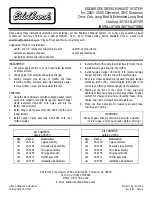
STARTING AND OPERATING
35
Operating in 4WD Low the locker can be
engaged up to 40 mph (64 km/h) and will
remain engaged throughout the 4WD Low
speed range.
Operating the locker in 4WD Auto and 4WD
High, the locker can be engaged up to 20 mph
(32 km/h). It will remain engaged throughout
the entire 4WD speed range
NOTE:
Left to right wheel speed difference may be
necessary to allow the rear axle to fully lock. If
the indicator light is flashing after selecting the
rear axle lock mode, drive the vehicle in a turn
or on loose gravel to expedite the locking action.
The axle locker could become torque locked
due to side to side loads on the rear axle.
Driving slowly while turning the steering wheel
from a left hand turn to a right hand turn or
driving in REVERSE for a short distance may be
required to release the torque lock and unlock
the axles.
To unlock the rear axle; push the AXLE LOCK
button. The AXLE LOCK indicator light will go out
when the rear axle is unlocked.
DRIVING TIPS
O
N
-R
OAD
D
RIVING
T
IPS
Off-road trucks have higher ground clearance
and increased suspension travel to make them
capable of performing in a wide variety of
off-road applications. Specific design
characteristics give them a higher center of
gravity than conventional passenger cars.
An advantage of the higher ground clearance is
a better view of the road, allowing you to
anticipate problems. They are not designed for
cornering at the same speeds as conventional
passenger cars any more than low-slung sports
cars are designed to perform satisfactorily in
off-road conditions. Avoid sharp turns or abrupt
maneuvers. As with other vehicles of this type,
failure to operate this vehicle correctly may
result in loss of control or vehicle rollover.
O
FF
-R
OAD
D
RIVING
T
IPS
The Basics Of Off-Road Driving
You will encounter many types of terrain driving
off-road. You should be familiar with the terrain
and area before proceeding. There are many
types of surface conditions: hard-packed dirt,
gravel, rocks, grass, sand, mud, snow and ice.
Every surface has a different effect on your
vehicle's steering, handling and traction.
Controlling your vehicle is one of the keys to
successful off-road driving, so always keep a
firm grip on the steering wheel and maintain a
good driving posture. Avoid sudden
accelerations, turns or braking. In most cases,
there are no road signs, posted speed limits or
signal lights. Therefore, you will need to use
your own good judgment on what is safe and
what is not. When on a trail, you should always
be looking ahead for surface obstacles and
changes in terrain. The key is to plan your future
driving route while remembering what you are
currently driving over.
WARNING!
Always wear your seat belt and firmly tie down
cargo. Unsecured cargo can become
projectiles in an off-road situation.
CAUTION!
Never park your vehicle over dry grass or
other combustible materials. The heat from
your vehicle exhaust system could cause a
fire.
4
21_DT_TRX_SU_EN_USC_t.book Page 35
















































